Many thanks once again to all those who engaged in the callout for this week’s Coach’s Corner.
What is it about the Reds that have them start slowly but come roaring back in the back end of games?
– Zero_Cool
One of the many frustrating elements of Australian rugby in recent years has been the inability to manage a game in the dying stages – how do teams develop this ability?
– Herr Red
A lot has been said about Liam Wright’s ‘influence’ late in the Reds-Brumbies game… What effect do you think a team’s momentum has on a referee’s decision-making?
– JC
The Queensland Reds are the best finishers in Super Rugby AU. No question about it. They have won the last quarters of their games by a grand total of 95 points to 15 over the seven fixtures played so far.
In four of those – against the Rebels in Round 2, the Force in Round 5, and the Brumbies in Rounds 4 and 8, they have overhauled an opposition lead at the hour mark.
The Brumbies will feel particularly aggrieved, having lost the final quarters by an aggregate of 34-7 after leading both games by more than one score after 60 minutes of play.
One of the main reasons for the Reds’ ability to press the turbo button in the final quarter of the match at the Suncorp was their key substitution of second-rower Ryan Smith for club captain Liam Wright in the 53rd minute. With Angus Scott-Young shifting up alongside Lukhan Salakaia-Loto and Wright joining Harry Wilson and Fraser McReight behind them, Queensland had the luxury of five players who had played extensively in the back row, including two in the number seven jersey.
That gave the Reds a significant advantage in mobility, and the last quarter was the only period of the game in which they succeeded in dominating the points of contact. At the same time, they lost nothing in cohesion at the set-piece, winning all five of their lineout throws and generating the decisive scrum penalty only four minutes before the final whistle.
Let’s look at a couple of sequences where the field coverage of the Reds’ back five forwards was the most influential factor in producing turnovers:
The Brumbies want to shift the ball wide and repeat the success their back-rowers enjoyed in the 15-5m channels at GIO Stadium. But when replacement James Tucker receives the ball in that zone, he is confronted by no fewer than three experts at the post-tackle: Fraser McReight, Liam Wright and Filipo Daugunu. Coverage is also good on the far side with Salakaia-Loto and Scott-Young manning the barricades and Wilson getting up from the previous tackle:
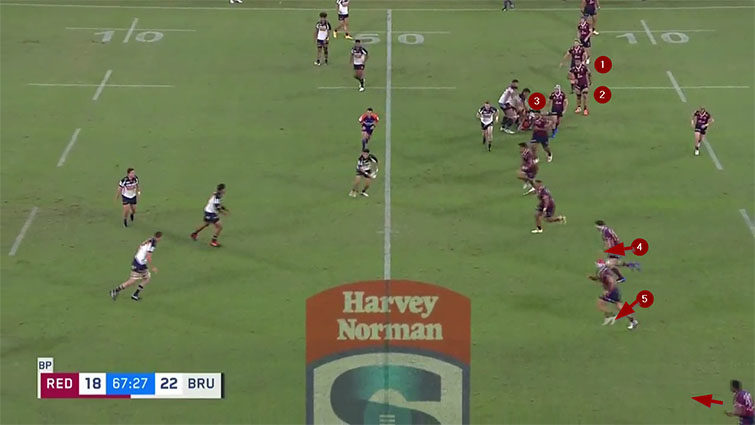
After the powerful counter-ruck led by the twin sevens, there is only going to be one result on the following phase with the back five closing around the ball and McReight and Wright already back on their feet.
The second example occurred in a prime Brumbies scoring scenario close to the Reds’ goal-line:
There is going to be no pushover with Wright breaking through the left side of the blocking wall at 72:12. After that, the Reds’ ability to get two back-rowers on the ball was the deciding factor:
Angus Scott-Young hammers McReight into the breakdown like a nail, and in response to JC’s other question, “about the Fraser McReight turnover. To me, it seems clear that he is not supporting his body weight. How do you see it?”, it looks like McReight is on his feet, on the ball, and supporting his weight.
The turnover had been set up on the play before, with two Brumbies left on the ground and all of the Queenslanders on their feet and in play:
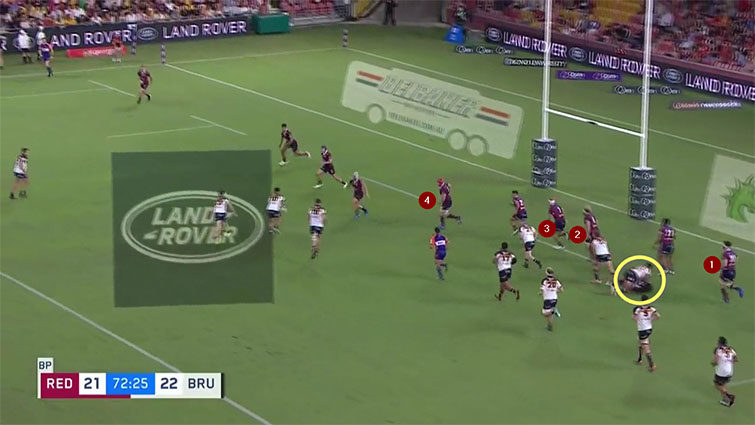
For good measure, Zero_Cool added one more question about the Wallabies’ number seven spot.
“What is your view on Michael Hooper’s captaincy? Is it perhaps time we tried someone new, James O’Connor? And is Hooper even the best seven we have, with McReight in imperious form both last year and continuing this year?”
Short answer: Michael Hooper is the man in possession of the number seven jersey and there is no reason for him to lose it in absentia – but I think Dave Rennie may well be looking for an alternative captain.
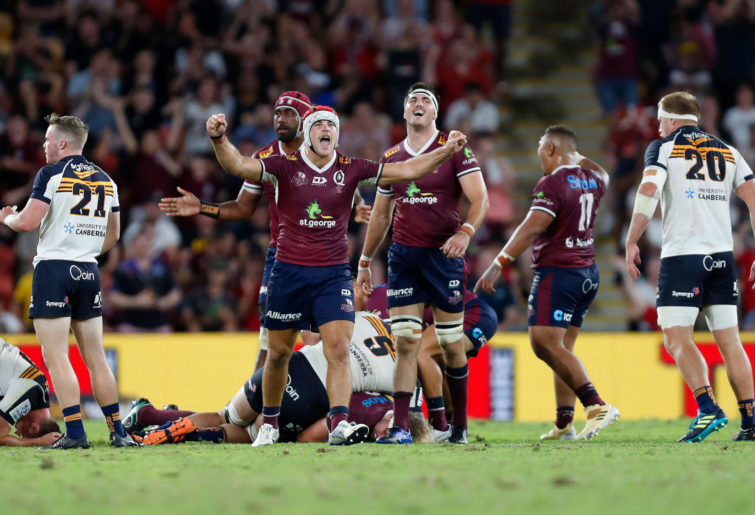
Fraser McReight. (Photo by Regi Varghese/Getty Images)
I’ve noticed Australian teams have a semi-common issue that doesn’t seem to afflict Kiwi teams as much – when an attacking player succeeds ‘too much’ through a semi-break or making more ground than expected, our support players always seem surprised and too far behind the play to ensure the success is exploited or even just adequately supported through cleanouts etc. Why is this? What do Kiwi teams do that is different and are they doing this at the expense of something else?
– Chunks
In my experience, New Zealand teams have always been the best at supporting a bust and defending the support channels after conceding a break. It was a feature that was noticeable on the 2014 England tour of New Zealand, where the visitors made as many breaks as the All Blacks but converted far fewer opportunities into tries.
On attack, the main support runner is nearly always the number nine, whose job is to track the ball from ruck to ruck from the inside. He should always be the first port of call and you ignore him at your peril, as last weekend’s game between the Force and the Rebels showed:
Pone Fa’amausili makes a long break down the centre of the field, but he ignores the obvious support of Joe Powell to his left and makes a more difficult pass which hamstrings the momentum.
The best in the game right now is France and Toulouse scrumhalf Antoine Dupont. Dupont’s great engine and acceleration often shoot him clear of the covering defence.
The other keynote of successful support after a break is the need for attackers to stay in the pocket – the space directly behind the ball-carrier – for as long as possible:
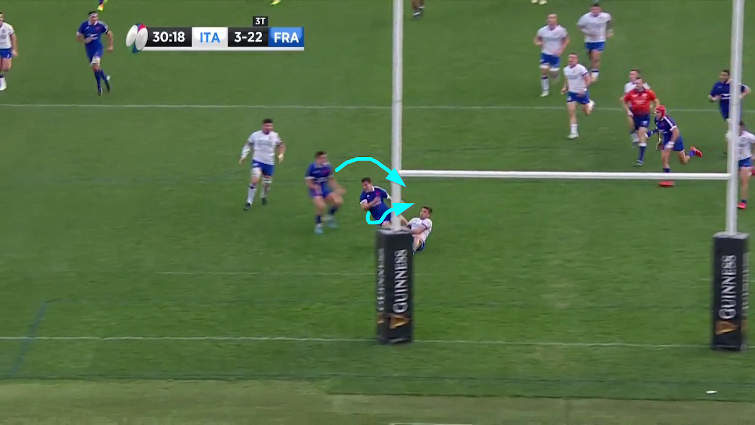
First Dupont drops neatly into the slipstream of the player who recovers the loose ball (Vincent Rattez in the red hat), then France number 13 Artur Vincent falls in behind his scrumhalf to receive the scoring offload. That gives the passer the maximum number of options. There is a terrific session on the technical details of support play given by Wayne Smith on the Rugby Site.
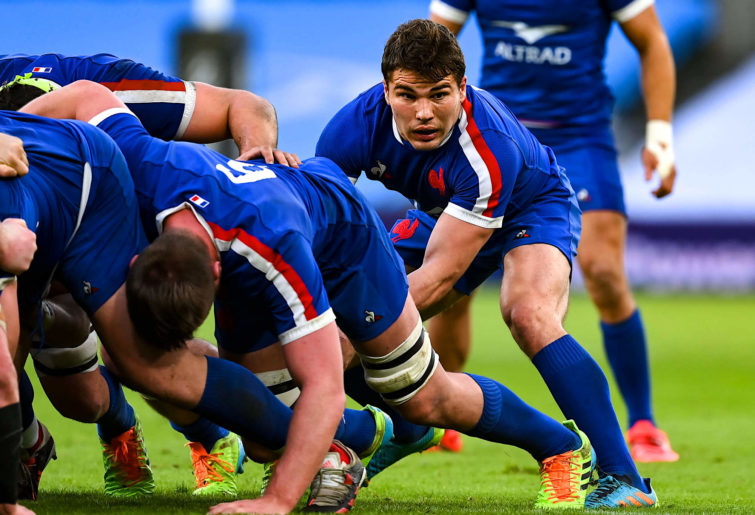
Antoine Dupont. (Photo By Brendan Moran/Sportsfile via Getty Images)
Is it time we had something in place for occupying space around the high ball without genuinely contending for it? What would you do to clean this up? Would you want to? Call obstructions for off-the-ball play?
– Kiwiburger
For the side defending a high kick, it is quite permissible for players ahead of the ball to run back towards the point of receipt, provided that they do not deliberately change their line to block out an opponent.
Unfortunately, this aspect of play was not refereed by Nic Berry in the Reds-Brumbies game. There were two flagrant examples in the first half where Brumbies defenders clearly altered their lines in order to block out the Queensland chasers:
In the first instance, Jordan Petaia is shadowed so closely that he has to run across the sideline to find some room – only to be blocked out on the way back by Nic White.
In the second, the two Queensland chasers are quite obviously either bumped or dragged off their line into the receiver by intentional blocks. It is the sort of event which is viewed far more harshly by European referees.
Why is the ‘bloke rolled too far after being tackled’ law being so stringently applied this year? Was there some kind of spate of too much rolling around that triggered it?
– Piru
In short, yes. One of the main planks in the new law interpretations at the tackle was to prevent double movements on the ground by the ball-carrier. When the ball-carrier is allowed to either execute another roll on the deck or place it for a second time, he can effectively offset a defensive player who would otherwise pick up the ball legally:
Under the old protocols, England flanker Tom Curry could roll on the ground before presenting the ball to his scrumhalf. That stops Ardie Savea from making the pilfer, it gives Curry’s cleanout support more impetus, and it leaves three All Black forwards offside and required to retreat for the next phase.
It is no surprise that there is some space for England to move the ball successfully down the right as play continues. I wrote about that in more detail back in June of last year.
Thanks to all who contributed a question this week, all those that went unanswered are stored on file and may get a response in columns to come!

































































































